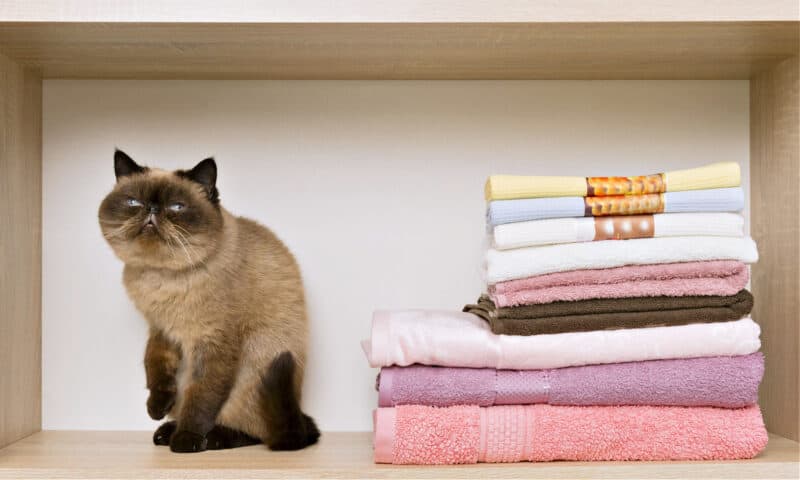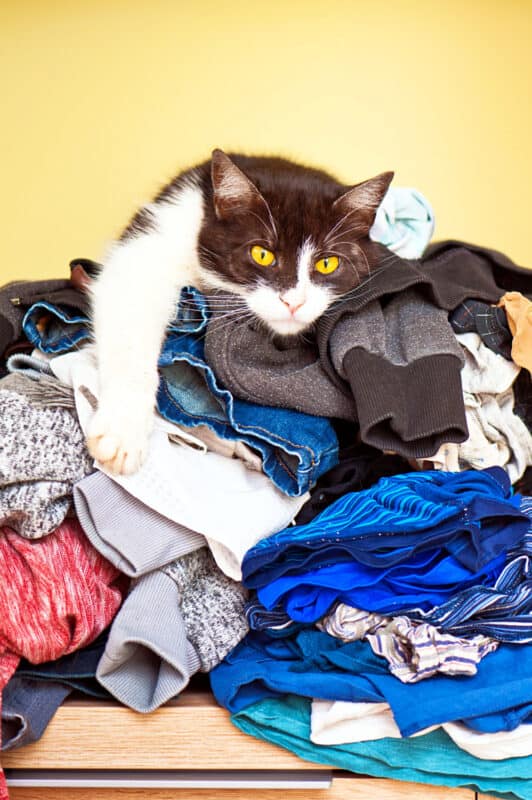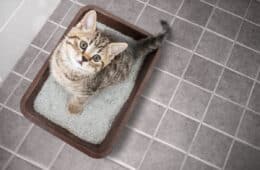Dealing with the unpleasant odor of cat urine on your clothes and linens can be a frustrating challenge. In this article, we will explore effective methods to get cat pee smell out of clothes and linens.
From household remedies to specialized products, we will cover a range of options to help you solve this problem.
Discover the best techniques to remove cat urine odor and regain fresh-smelling clothes and linens. Say goodbye to the lingering scent of cat pee with these proven solutions.
Eliminating Cat Pee Smell: Effective Solutions For Clothes and Linens
Whenever a cat pees outside the litter box - the owner is facing a problem.
Dealing with a potentially complex medical or behavioral problem can be frustrating. Additionally, there is the issue of managing the smell.
Removing the smell can alleviate your own suffering and be a step in the way to solving the problem.
OdorKlenz, the author of this article, offers solutions for all your cat urine cleaning needs. From litter additives to urine removal products, OdorKlenz can help you keep your home free of cat urine stench.

Why Is Kitty Not Using The Litter Box?
It is incredibly stressful to deal with medical problems that disguise themselves as behavioral issues.
Cat lovers who have been around the block understand that when their cats start urinating in unusual places, there may be an underlying medical issue. This behavior can be a sign of potential health problems.
The heartache and confusion that comes with trying to determine the issue can bring even experienced cat owners to a place of helplessness. It can be overwhelming to figure out what's causing the problem.
Now, compound that feeling and concern with the persistent unpleasantness of your bed, your clothes, your bags, or shoes smelling like cat pee. This combo can send anyone into a deep spiral of frantic frustration.
Your life becomes consumed by the demands of solving multiple mysteries at once! Why is this happening? Is it a bladder infection? Could it be dry food? Does it have to do with litter box placement? Is it territory marking? Are UT crystals causing pain? Is it dementia?
A cat owner will need to investigate and find answers to these questions. It often involves trial and error, as well as vet visits, to get to the bottom of the issues.
Dealing With Cat Pee Smell
Simultaneously, you embark on a trial and error process to eliminate the cat pee smell from clothes. You also strive to remove the pungent urine odor from bedding.
People prioritize the urgent hunt for the most effective odor-removal method. This takes precedence over the desire to be surrounded by pleasant smells alone.
If your cat starts to smell the residue of their urine in certain fabrics and surfaces, they will begin to associate those spots with "places they should pee." This cycle becomes a very difficult habit to break.
As an experienced cat owner who has gone through this firsthand, here are a few ways you may want to try to remove the smell of cat pee from your clothes or linens. These methods are listed in order from being the least to most effective in nearly 100% of the time.
Using Baking Soda To Clean Cat Pee Smell
Baking soda is a safe and familiar favorite. One of its advantages is that it is extremely affordable. Additionally, more often than not, you most likely already have some sitting around somewhere in your fridge or cupboard.
It is also an amphoteric substance, which means it can act as either an acid or a base. This trait enables it to transform odor-causing compounds into less volatile salts. This greatly reduces the level at which you perceive a “smell” or “odor”.
Unfortunately, the compound that causes the most offensive odor in cat urine is uric acid. After forming into uric salt crystals (due to baking soda), it can become reactivated when there is an increase in humidity.
This is what causes the “phantom” pee smell that seems to linger and reappear no matter how many times you clean the offending item. This also means that those uric salt crystals could become reactivated in the wash or from the warmth of your body down the road. No bueno.
Using White Vinegar To Clean Cat Pee Smell
Also a major win in the money-saving department, you can buy a giant jug at Costco for a song. Vinegar has an acidic ph, which neutralizes the alkaline ph of cat urine.
To ensure effective odor removal, apply a 1:3 vinegar mixture to the pee area of the clothes within 10-15 minutes of the incident. Also, let it sit for at least 20 minutes.
Wash with cold water without any detergent. Then, let air dry (heat from a dryer could set in the smell). The downside is vinegar, though not as offending as cat pee, can leave its own scent.
Using Bleach To Clean Cat Pee Smell
Adding bleach to the washer may tempt some people to eliminate the cat pee smell from clothes or linens.
While bleach is effective at removing stains, killing bacteria, and transforming the smell of cut pee. It reacts negatively with the ammonia in cat urine to create chloramine vapor which is a dangerous lung irritant.
You will be severely disappointed if you hope to remove the cat pee smell from your clothes. Have you ever visited an indoor pool and experienced the overpowering, eye-burning smell?
Well, that isn’t the chlorine itself.
That’s the vapors from the combination of chlorine and ammonia from people peeing in the pool. Yeah, gross. So adding bleach to your wash when trying to clean items doused in cat pee will create a perfect storm of nauseating stench.

Using Enzymatic Cleaners To Clean Cat Pee Smell
Enzymatic cleaners utilize enzymes that target items with a specific chemical makeup, like proteins, fats, or starches.
Each enzyme speeds up a specific chemical reaction that breaks down its corresponding chemical component.
The process deconstructs the cat urine odor-causing chemicals that the product has been formulated to address. This renders them undetectable to the human nose as the offending smell that they once were.
Enzymatic cleaners are highly effective when they are matched correctly. However, their effectiveness may be reduced if there are chemical components that detergent enzymes are not suited to break down.
Enzymes also have very specific environmental needs in order to work effectively. Examples include moisture levels, ph levels, temperature range, and preventing exposure to other chemicals.
Some cat owners have noticed that enzymatic cleaners may not always be effective in removing pheromones present in their pet’s urine. This causes them to continue to re-soil in the same location. Even though the owner may no longer be able to smell the former stain.
If your cat’s urine has been altered by medication, this could also inhibit the effectiveness of the enzymes.
For the most part, if you make sure that it is designed to get cat pee smell out of clothes or lines, an enzymatic cleaner is a decent option (particularly to remove stains). Most enzyme-based laundry detergents have been formulated to break down the proteins that cause stains to bind to fabric fibers.
SIGN UP FOR THECATSITE'S EMAIL UPDATES >
Using Carbon, aka Activated Charcoal To Clean Cat Pee Smell
Activated Charcoal is incredibly effective at absorbing odors and other noxious chemicals. This is why carbon filters are effectively used in many high-end kitty litter boxes. They help address odor issues that may arise.
There are also activated charcoal sashays that can be hung on door handles or hooks that can also help absorb ambient smells that may be accumulating in a particular room. Activated Carbon works like velcro, with chemical compounds latching onto tiny pores on the surface of the carbon.
These pores increase the surface area, which in turn, allows a substantial amount of compounds to attach to individual particles of charcoal.
Removing Cat Pee Smell From Mattresses
In order to get the cat urine smell out of, let’s say a mattress, with activated charcoal in an effective way, it is recommended to blot away any liquid you can and then cover the stain with a thin cotton cloth that you do not mind staining or that is black in color.
Then, place a relatively thick layer of activated charcoal on top and let sit for at least several hours, or ideally, a few days.
Despite effectively absorbing cat pee urine, activated carbon is not without its own potential to stain or cause messes (can we just take a moment to imagine our little friend sneaking back into the off-limits area and then covering the house in little black paw prints?).
Due to staining, using carbon would not be an effective option for washing soft goods in order to remove the cat pee smell from clothes or sheets.
Release Of Offending Odors
And given that things just “stick” to carbon as opposed to being fully absorbed by it, and/or the carbon altering their chemical composition into a neutral form, it is possible for the carbon to release the offending gasses back into the environment if the carbon is put under stress from heat or humidity changes.
Activated carbon, however, would be great for addressing ambient odors in certain rooms, refrigerators, or storage containers in the form of sashays.
Using Nano Active Metal Oxides To Clean Cat Pee Smell
These are a collection of minerals found naturally in earthen material, Magnesium Oxide (MgO), Zinc Oxide (ZnO), and Titanium Dioxide (TiO2), that have undergone a patented process in which to increase the usable surface area and pore volume of each mineral particle and getting both physical and the full chemisorption activity of nanomaterials, without being hard to manage nanoparticle.
Utilizing Nanoactive Metal Oxides was developed by the Nanochemistry Technology firm, Timilon, this nanotech has been used in applications for the Department of Defense, Environmental Protection Agency, and the National Institute of Health.
OdorKlenz: Nano Active Metal Oxides In Consumer Products
Now Timilon has launched a line of consumer products that utilize their nanotech branded as OdorKlenz, which covers a variety of household needs like air filtration, cleaning, and laundry.
When it comes to eliminating the smell of cat pee from clothes and bedding, your best bet will be to use a tried and true laundry additive like that of OdorKlenz. The nice thing about OdorKlenz’s nano active metal oxides is that they effectively combine the adsorption power of activated carbon with the chemical neutralizing power of enzymes.
The Power Of OdorKlenz: Absorption And Chemical Neutralization
White paper tests reveal that OdorKlenz had a 31% increase in absorption capacity over carbon, plus it has the capability to neutralize once offensive or dangerous chemicals altering them into a benign form.
Thankfully, Odorklenz has benefited from testing that ensures their products are safe, even for people with acute chemical sensitivities, thus making their products an excellent option for pet owners who want a safe and effective solution to their cat pee smell problem. They even have a whole line tailored to address pet odors under subflooring and deep within carpet padding.
Combating Repeat Urination Spots
The combination of adsorption and chemisorption is what makes Odorklenz ideal for combating repeat urination spots because it removes any trace of smell, not only from our human nose but also from the highly sensitive nose of your cat which helps prevent them from forming a pattern of going in a certain spot time and again.
If you are having trouble getting cat pee smell out of clothes and linens, a nano-active metal oxide will be your best bet.
SIGN UP FOR THECATSITE'S EMAIL UPDATES >
Note: We may get commissions for purchases made through links on this page.




9 comments on “How To Get Cat Pee Smell Out Of Clothes And Linens”